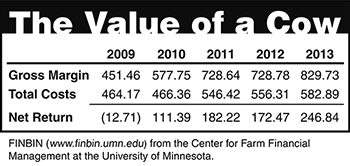
Kris Ringwall
Beef Talk
Do the math: Income minus cost equals net return.
For those who do math, what is $713 minus $537? The answer is $176. Good numbers, especially for the cow-calf producer, because the $713 indicates the amount of cash that cows have been able to generate after adjusting for replacements. The $537 indicates the recent costs to keep a cow for the year.
The end result is a positive $176 per cow since the turn of the decade. It is interesting when one realizes the average cow was in the red, in other words losing money, in 2009. The cow-calf business has been good recently, and it continues to see positive returns, according to the North Dakota Farm Management education program (www.ndfarmmanagement.com), along with FINBIN (www.finbin.umn.edu) from the Center for Farm Financial Management at the University of Minnesota.
 These programs provide enterprise analysis for many agricultural operations, including beef cows, and are well worth reviewing. In reality, even most of the herds that are at the lower end of the net income scale are in the black. The value of the product, in this case the feeder calf, certainly is reflecting short supplies and a desire of the market to make strong bids to fill the trucks.
These programs provide enterprise analysis for many agricultural operations, including beef cows, and are well worth reviewing. In reality, even most of the herds that are at the lower end of the net income scale are in the black. The value of the product, in this case the feeder calf, certainly is reflecting short supplies and a desire of the market to make strong bids to fill the trucks.
Producers should not assume a good, solid handshake and slap on the back means top dollar was achieved in marketing this decade’s calves. Public auction barns and other competitive markets certainly will do their best to get the best value for the calves presented.
However, producers need to do their part, as well. Some good street sense, a feel for the costs of maintaining producing herds, associated direct costs of producing the calf and overhead costs, along with a savvy marketing plan, are all needed if one is not going to return to the 2009 numbers.
A quick review of the FINBIN numbers is important. The place to start is gross margin. Gross margin accounts for the purchase and sale of all calves, cull cows and bulls, plus the animals transferred in and any overall changes in cattle inventory.
In 2013 the gross margin per cow was $830, in 2012 it was $729, in 2011 it was $729, in 2010 it was $578, and in 2009 it was $451. Gross margins have increased by 184% in five years.
If a producer wants to keep control of long-term survival, then costs need to be controlled.
On the flip side, the challenge is costs. Some costs are obvious and some are not so obvious. Profitability is only positive when expenses are less than income received, which is not rocket science. However, in the beef business, particularly the cow-calf enterprise, the numbers that actually are used in the assessment of profitability are not always complete.
Again, a quick review of the numbers is important. In 2013, the total cost per cow was $583, in 2012 it was $556, in 2011 it was $546, in 2010 it was $466 and in 2009 it was $464. Total costs per cow have increased 126% in five years. Those are good numbers, but they also point out that the current positive impacts in the cow-calf enterprise are being driven significantly by the market as cow-calf producers try to keep costs down.
During good income years, the tendency also may creep in to not track expenses. In fact, the income check may be large and actually overshadow the size of numerous expense checks that were written or expenses allotted to the beef enterprise during the course of the production year.
If a producer wants to keep control of long-term survival, then costs need to be controlled. The market is not under producers’ control, so if the goal is not to repeat 2009, then costs must be controlled.
In summary, for North Dakota herds, the average herd returned (more than direct and overhead expenses) $247 per cow in 2013, which was up from $172 in 2012, $182 in 2011, $111 in 2010 and obviously up from a minus $13 that was lost in 2009.
Is this sustainable? Only if significant income continues and costs are controlled. Assessing income in a cow-calf enterprise is more than just the price received for the calves. The measuring stick that is most beneficial is the calculation of gross margin per cow. That value is not the same as the calf value per cow because there are multiple sources of income within a cow-calf enterprise.
Once the gross margin is known, focus on direct and overhead costs as one evaluates a cow enterprise. At the end of the day, net return to labor and management only is real if the cost and income side of the operation have been assessed properly. Sustainability rests with the producer.
Again, do the math by taking income and subtracting the costs.
May you find all your ear tags.
Your comments are always welcome at www.beeftalk.com. For more information, contact the NDBCIA Office, 1041 State Ave., Dickinson, ND 58601, or go to www.CHAPS2000.com on the Internet.

Editor’s Note: Kris Ringwall is a North Dakota State University Extension Service livestock specialist and the Dickinson Research Extension Center director.
[Click here to go to the top of the page.]






